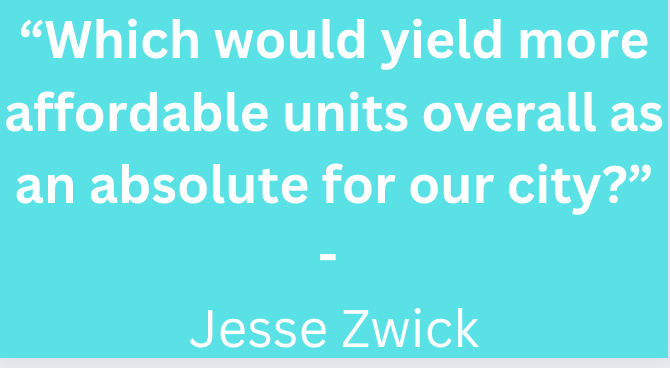When is 15 greater than 20?
This was one of many complicated questions the Santa Monica City Council wrestled with on Wednesday, and the answer could decide how the city attacks its affordable housing shortage.
The seven and a half hour (watch the full 7 hour and sixteen minute meeting on YouTube) meeting focused on updates to the city’s housing element. Much of the discussion focused on whether or not the city should upzone Neighborhood Commercial Districts to meet its housing demands. In the end, they voted to maintain the current zoning and work with the state to insure that the plan stays inside of the state’s mandatory housing goals.
But another issue that wasn’t resolved was where to set the inclusionary zoning mandate for larger residential developments. In Downtown, city staff recommended requiring that for larger housing developments, that 15% of all units be set aside as affordable. Some on the Council wanted to see that number be set higher. The Council will consider other amendments to the housing plan at next Thursday’s regular meeting.
Supporting the idea of increasing the percentage was Councilmember Phil Brock, who seemed enthusiastic for bringing more affordable units
But other Councilmembers, Jesse Zwick, Carolyn Torosis and Mayor Gleam Davis, pushed back on raising the mandated percentage. Zwick pushed city staff on whether or not the city might see less larger housing projects overall, which would lead to less affordable housing.
For example, if two developers are planning two buildings of 20 units each, under a plan that required 15% be affordable, it would produce six units of affordable housing. If the city raises that requirement to 20% and one developer drops out, it now only produces 4 units.
Zwick pointed to the Downtown Community Plan (DCP), passed by the Council in 2017. At the eleventh hour, after hundreds of hours of community outreach, the Council voted for a Downtown Community Plan that increased affordable and subsidized housing requirements well beyond what staff recommended.
Under the DCP, in projects 40 to 50 feet tall, 20 percent of the units would have to be subsidized housing. Then for every two feet of height beyond 50 feet, another percent of affordable units is required. For example, at 60 feet, the developer would have to include 25 percent subsidized units and at 70 feet, 30 percent.
There are no housing projects that have been proposed under the DCP that are 60 feet high, to say nothing of projects that are 70 feet or higher. In 2017, advocates predicted this result, and even accused the Council of manufacturing it.Santa Monica is not alone experiencing mixed results with a mandatory inclusionary housing requirement. A 2021 study by Emily Hamilton at George Mason University entitled Inclusionary Zoning and Housing Market Outcomes showed that nationwide cities have had mixed results when mandating affordable housing in otherwise market-rate housing projects. The UCLA Housing Voice Podcast has an episode with Hamilton breaking down the report’s findings that you can find here.
Which leads us back to the current debate over the housing element today. Zwick pushed staff to predict whether or not the city would see more affordable units built with a 15% requirement versus a 20% requirement. Staff didn’t want to get into hypotheticals, but conceded that a higher requirement may not lead to more units. They also shared a story about a developer that walked away from a project after the city required 20% affordable as opposed to 15% affordable because their profit margin vanished.
If the Council changed the staff recommendation higher, the city would likely have to eventually increase the supply in other parts of the city the same “upzoning” that it voted against late in the evening or risk falling out of compliance with state housing laws. No matter where one stands on the city’s housing policy, there is broad agreement that the city doesn’t want to be subject to the builder’s remedy.

